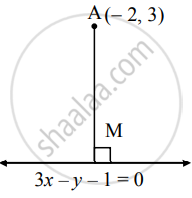Advertisements
Advertisements
Question
Find the co-ordinates of the foot of the perpendicular drawn from the point A(–2, 3) to the line 3x – y – 1 = 0
Solution

Let M be the foot of perpendicular drawn from point A(– 2, 3) to the line
3x – y – 1 = 0 ....(i)
Slope of the line 3x – y – 1 = 0 is `(-3)/(-1)` = 3.
Since AM ⊥ to line (i),
slope of AM = `(-1)/3`
∴ Equation of AM is
y − 3 = `(-1)/3` (x + 2)
∴ 3(y − 3) = −1(x + 2)
∴ 3y − 9 = −x − 2
∴ x + 3y − 7 = 0 ...(ii)
The foot of perpendicular i.e., point M, is the point of intersection of equations (i) and (ii).
By (i) × 3 + (ii), we get
10x – 10 = 0
∴ x = 1
Substituting x = 1 in (ii), we get
1 + 3y – 7 = 0
∴ 3y = 6
∴ y = 2
The co-ordinates of the foot of the perpendicular M are (1, 2).
APPEARS IN
RELATED QUESTIONS
Find the slope, X-intercept, Y-intercept of the following line:
3x − y − 9 = 0
Find the slope, X-intercept, Y-intercept of the following line:
x + 2y = 0
Write the following equation in ax + by + c = 0 form.
y = 2x – 4
Write the following equation in ax + by + c = 0 form.
y = 4
Write the following equation in ax + by + c = 0 form.
`x/2 + y/4` = 1
Show that lines x − 2y − 7 = 0 and 2x + y + 1 = 0 are perpendicular to each other. Find their point of intersection
Find the co-ordinates of the orthocenter of the triangle whose vertices are A(3, –2), B(7, 6), C(–1, 2).
Find the distance of the origin from the line 7x + 24y – 50 = 0
Find the distance of the point A(−2, 3) from the line 12x − 5y − 13 = 0
Find the equation of the line parallel to the X-axis and passing through the point of intersection of lines x + y − 2 = 0 and 4x + 3y = 10
Find the equation of the line passing through the point of intersection of lines x + y − 2 = 0 and 2x − 3y + 4 = 0 and making intercept 3 on the X-axis
D(−1, 8), E(4, −2), F(−5, −3) are midpoints of sides BC, CA and AB of ∆ABC Find equations of sides of ∆ABC
O(0, 0), A(6, 0) and B(0, 8) are vertices of a triangle. Find the co-ordinates of the incenter of ∆OAB
Select the correct option from the given alternatives:
If A(1, −2), B(−2, 3) and C(2, −5) are the vertices of ∆ABC, then the equation of the median BE is
Select the correct option from the given alternatives:
The equation of a line, having inclination 120° with positive direction of X−axis, which is at a distance of 3 units from the origin is
Answer the following question:
Find the distance of the origin from the line x = – 2
Answer the following question:
Obtain the equation of the line which is parallel to the Y−axis and 2 units to the left of it.
Answer the following question:
Obtain the equation of the line which is parallel to the X−axis and making an intercept of 5 on the Y−axis.
Answer the following question:
Find the distance of the origin from the line 12x + 5y + 78 = 0
Answer the following question:
Find the equation of the line which passes through the point of intersection of lines x + y − 3 = 0, 2x − y + 1 = 0 and which is parallel X-axis
Answer the following question:
Find the distance of P(−1, 1) from the line 12(x + 6) = 5(y − 2)
For the lines 5x + 2y = 8 and 5x - 2y = 7, which of the following statement is true?
The length of perpendicular from (1, 3) on line 3x + 4y + 10 = 0, is ______
The y-intercept of the line passing through A( 6, 1) and perpendicular to the line x - 2y = 4 is ______.
Let the straight line x = b divide the area enclosed by y = (1 - x)2, y = 0 and x = 0 into two parts R1(0 ≤ x ≤ b) and R2 (b ≤ x ≤ 1) such that `R_1 - R_2 = 1/4`. Then b equals ______
The equation 12x2 + 7xy + ay2 + 13x - y + 3 = 0 represents a pair of perpendicular lines. Then the value of 'a' is ______
If a plane has x-intercept l, y-intercept m and z-intercept n, and perpendicular distance of plane from the origin is k, then _______.
If the distance of the point (1, 1, 1) from the origin is half its distance from the plane x + y + z + k = 0, then k = ______.
Find the distance of the origin from the line 7x + 24y – 50 = 0 is:
